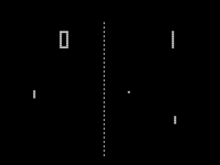Doctor Pong
| Doctor Pong | |
|---|---|
 | |
| Developer(s) | Atari Inc. |
| Publisher(s) | Atari Inc. |
| Designer(s) | Allan Alcorn, Nolan Bushnell, Steve Bristow |
| Series | Pong |
| Platform(s) | Arcade |
| Release date(s) | North America 1975 - 1977 |
| Genre(s) | Sports simulation |
| Cabinet | standard |
| CPU | discrete |
| Sound | Amplified Mono (one channel) |
| Display | Vertical orientation, Black-and-white raster display, Standard Resolution |
Doctor Pong, also known as "Puppy Pong" was an adaption of the original arcade Pong for use in a non-coin-operated environment. It was conceptualized by Nolan Bushnell, Steve Bristow and a marketing firm to move their arcade games into a non-arcade environment—in this case to help occupy children in pediatricians' waiting rooms. Originally designed to be model of Snoopy's dog house with Pong built into the side of it, when Charles Schulz declined Atari the use of Snoopy the model was changed to a generic doghouse with a puppy looking over the top. Puppy Pong saw a limited production run and was in testing stage at Chuck E. Cheese's early locations.[1]
Technology
The original Snoopy Pong cabinet was designed by Regan Cheng of the Atari Industrial Design group. The follow-up Puppy Pong cabinet was designed by Regan's manager, Chas Grossman.[1]
Both cabinets consisted of a dog house housing a Pong board modified to not use a coin drop as a start trigger. The original Pong automatically starts several seconds after a coin is inserted. In Doctor Pong and Puppy Pong, a "start button" was instead wired up to start the games, set under the vertically mounted television in the dog house "roof". Instead of a traditional control panel, spinners are mounted directly on the roof as well.
References
- ↑ 1.0 1.1 Vendel, Curt. "Atari Puppy Pong". Retrieved 2007-07-27.